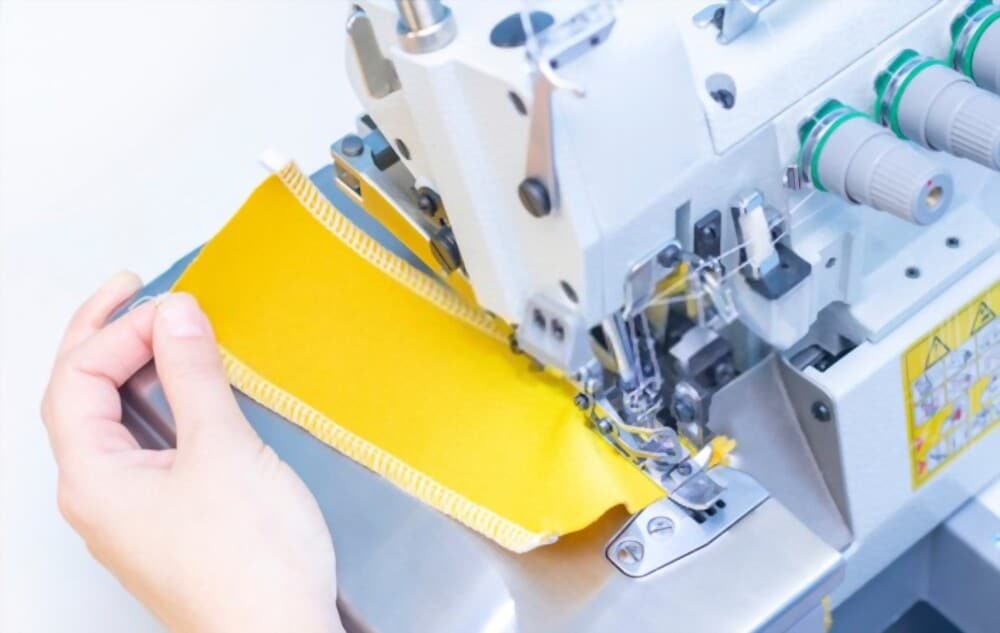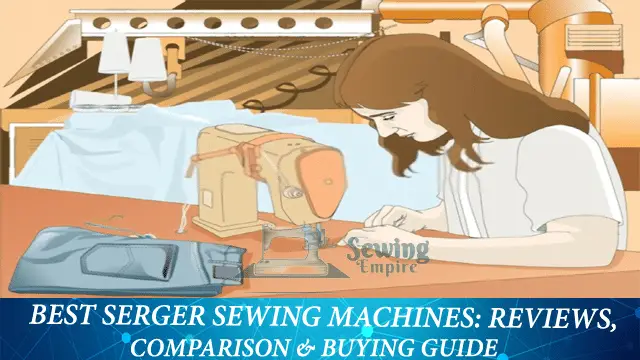Learn how to use a serger machine! A serger is a great way to finish your sewing projects. It is also very easy to use, so anyone can do it!
Recently, I’ve been getting more and more requests to teach people how they can use their overlockers. Sergers are really popular now because of all the different techniques you are able to do with them!
So let me walk through some basics for serging: what is it? What does a stitch cutter look like (in case your machine doesn’t have one), which needles should be used on each type of thread…and so much more!
- Overlocker vs Serger
- What Can You Do With A Serger?
- How To Use A Serger Machine – Parts Of A Serger
- 2-3-4 or 5 Thread Serging
- How To Thread A Serger?
- How To Use A Serger When Sewing?
- How To Use A Serger For Curves
- How To Use A Serger Machine For Corners
- 10 Best Beginner’s Serger Tips
- Frequently Asked Questions(FAQs)
- Check Out These Posts Too!
Overlocker vs Serger
What Is An Overlocker?
What does an overlocker do? Well, that depends on the model and make. They can be used for both construction finishing or seaming fabric at one time depending on what you want your finished product to look like–usually with two threads but some could use up as many 8 if needed!
We’ll go into more detail about how each of these things works later in this article though so keep reading ahead before making any decisions today!

What Is A Serger?
A serger is an overlocker. You can use the term interchangeably– basically, it boils down to who’s talking about them!
Overlocking, as a verb or adjective for this machine (over-locking), has gained more popularity in Europe than America because BERNINA has its roots there originally from Switzerland.
For Full Detail Visit: What Is Serging?
What Can You Do With A Serger?
A serger can perform many functions including:
- Sewing seams
- Overcasting edges
- Making flatlock seams
- Creating rolled hems
- Gathering
- Can handle stretchy fabrics as well
How To Use A Serger Machine – Parts Of A Serger
Before going for a serger, look for the main parts of a serger & its functions. The main parts of a serger are:
- Tension dial – this part of the serger is very important as it controls the quality of the stitches
- 3 or 4 thread spool – thread spool is mentioned at the back of the serger
- # of needles – a serger has 2 needles but you can also sew with one also
- Stitch length dials
- Fabric cutting blade
- Differential feed dial
2-3-4 or 5 Thread Serging
Sergers are available with a variety of thread use options. You can create different stitches and results by using the number of threads that you choose in your project, which will cost more for each additional option.
A 2-4 thread serger:
This machine can do it all! It has the capabilities of a true safety stitch and an overlocked two-thread edge. Two threads are used on each operation so that you aren’t limited to one or the other type of stitch in your work.
A 3-4 thread serger:
These are machines that can function with three or four threads. Either amount will have a seam, but the four-thread seams offer greater durability and strength than two-layer fabric constructions; they also provide more coverage for fullness at stress points like shoulders where you want your garment to stretch without tearing apart under pressure from physical activity such as sewing up hems.
Some examples include mock safety stitches which work similarly but don’t quite substitute in all capacities – if it doesn’t have both stability AND mobility then go one way while still having accessorized options!
A 5-thread serger:
This machine is in the expensive range but has all of your seam capabilities. Three threads are used on an overlocked edge and two for a straight line, which you’ll find on ready-mades with chains around them.
When doing production work this can eliminate having to switch between machines during production time because they’re using three different types of threading methods combined into one!
How To Thread A Serger?
Threading a serger is easy! Follow the simple steps in your manual to get your machine threaded and ready for action in no time at all.
You may find that the first few times are more difficult than you think because there are several different thread sizes, but as soon as they become clear instructions it will be like riding an intuition train into productivity – who needs anything else?
On most models, the directions for threading can be found on an inner panel, and colors are set to assist with this process. The important thing to remember is that order matters!
How To Use A Serger When Sewing?
A serger is a wonderful tool for adding finishing touches to your project. The practice of test driving scrap before working on new garments will allow you the ability to use this fantastic machine with ease and creativity!
It takes some getting used o in the different features, but always know that if something isn’t right you can stop at any time without damaging anything or anyone around you (well maybe not everyone).
A sewing machine is a powerful tool that can produce some of the most intricate and beautiful seams in all the sewing. The presser foot, plate guide, and blade work together to create these neat edges for us with precision cutting skills like yours! Practice makes perfect so grab your fabric or thread now before it’s too late 🙂
How To Use A Serger For Curves
Convex Curve Instructions
Sitting in front of the machine with your fabric just below you, feed it gently and guide it around curves. Watch for excess fabric that will be cut off by blades as they go along their path while also making sure not to get too close or offside.
Concave Curve Instructions
This is a bit more fiddly as you have to space out your stitches in order not to see them, but if done correctly it will look like the purples and blues are running through an ocean.
Straighten the edge of the fabric with a blade; stick close while sewing so that there aren’t any gaps between layers before bunching up on the side (red arrow). Keep everything tight next time!
How To Use A Serger Machine For Corners
Once again, practice makes perfect.
Start sewing as normal along the first edge but stop at the end of it and take one or two stitches off before moving on to your next step which is taking care to pivot fabric in line with itself so you can turn corners without getting stuck on them!
10 Best Beginner’s Serger Tips
Are you new to sewing? Then read these tips before starting a sewing project on the serger.
- Always use good quality thread
- After opening the box, always several pics of the original threading
- Learn rethreading instead of making a knot of a thread for the next project
- A serger can’t backstitch so don’t try it
- Never sew on pins
- Don’t buy too many cones of a single color thread
- Create your personal threading book using different colors of thread & different tensions
- A serger goes faster as compared to a sewing machine. So don’t apply too much force on the foot pedal
- Learn how to use differential feed on different kinds of fabrics
- Clean your serger after every project as too much lint can be a disadvantage when serging
Hope all these tips & information about serging will help you to become a pro!
Happy Sewing!
{ "@context": "https://schema.org", "@type": "FAQPage", "mainEntity": [{ "@type": "Question", "name": "What is the difference between a serger and an overlocker?", "acceptedAnswer": { "@type": "Answer", "text": "Nothing, they are the same thing! It just depends where you live as to which term is used. For example, in America, we say serger and overseas when referring it’s an overlocker because there are so many different languages spoken around this world-language fusion called English also known by its initials ‘Engrish’." } },{ "@type": "Question", "name": "Does a serger replace a regular sewing machine?", "acceptedAnswer": { "@type": "Answer", "text": "A serger is a versatile machine that allows you to create professional-looking seams with the ease of your regular sewing machine. Most sewers use this tool for finishing off their projects and making sure they don’t fray in between washes, but it can also be used as an alternative if more handiwork than the head needs to be done!" } },{ "@type": "Question", "name": "Do you need a serger to sew knit?", "acceptedAnswer": { "@type": "Answer", "text": "Sergers are great for sewing on knit fabrics, but the durable stretchy seams will make you want one even if you don’t have one! Knit fabric can be sewn using a zig-zag stitch with any regular machine." } },{ "@type": "Question", "name": "What Is Differential Feed on a Serger?", "acceptedAnswer": { "@type": "Answer", "text": "Differential feed is the key to creative machine sewing. You can create a ruffled edge with it, and even make waves!" } }] }Frequently Asked Questions(FAQs)
What is the difference between a serger and an overlocker?
Nothing, they are the same thing! It just depends where you live as to which term is used. For example, in America, we say serger and overseas when referring it’s an overlocker because there are so many different languages spoken around this world-language fusion called English also known by its initials ‘Engrish’.
Does a serger replace a regular sewing machine?
A serger is a versatile machine that allows you to create professional-looking seams with the ease of your regular sewing machine. Most sewers use this tool for finishing off their projects and making sure they don’t fray in between washes, but it can also be used as an alternative if more handiwork than the head needs to be done!
Do you need a serger to sew knit?
Sergers are great for sewing on knit fabrics, but the durable stretchy seams will make you want one even if you don’t have one! Knit fabric can be sewn using a zig-zag stitch with any regular machine.
What Is Differential Feed on a Serger?
Differential feed is the key to creative machine sewing. You can create a ruffled edge with it, and even make waves!

Robert Patricia
Robert Patricia is a data analytic and content creator. He has worked extensively with large data sets to glean insights for both public and private sector clients. He has used this knowledge to create compelling content for brands across the internet. Albert also enjoys creating content for websites and social media. He is an expert at creating catchy headlines and understands how to capture the attention of readers.



